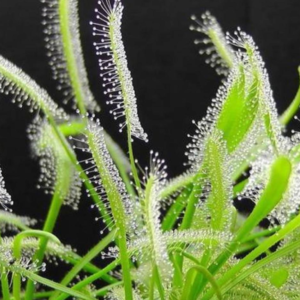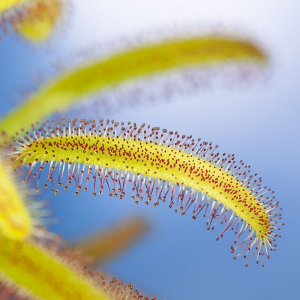Browse our current selection of drosera capensis for sale.
-
 Drosera Capensis Alba – 7.5cm£6.00
Drosera Capensis Alba – 7.5cm£6.00 -
 Cape Sundew – 9cm£11.00
Cape Sundew – 9cm£11.00
Buy Cape Sundew Plants Online
Are you looking for a unique house plant? You won’t find an easier sundew plant to get started with than the Drosera Capensis. It is commonly known as the Cape Sundew due to its origins in the Cape region of South Africa. Covered in fine red hairs, this carnivorous plant is sure to draw attention to its self. Its blooms can be a variety of colours. Depending on the variety of the sundew plant, it may bloom white, pink, or even violet. It will flower in the warmer months (May to September in the Northern Hemisphere) and produce multiple blooms along one stalk; these pods produce a number of seeds making the Drosera Capensis very easy for propagation.
The Drosera Capensis is perfect for a sunny, southern-facing window but will also do just fine in part-shade. Short on windowsill space? The Cape Sundew can also thrive under a plant light. Aside from providing adequate lighting conditions, you will want to ensure the proper soil for your new carnivorous plant. Cape Sundews prefer sandy, low-nitrogen soil. You can purchase a variety from our shop or mix 50 percent peat moss and 50 percent horticultural soil to form a simple formula.
Cape Sundew plants do not require fertilizer; nitrogen-based fertilizers can burn their roots and kill the plant. Instead, as carnivorous plants, sundews will require a steady diet of small insects, such as house flies, ants, and spiders. You can also feed the Drosera Capensis bloodworms and beta flakes.
When your Drosera Capensis comes in contact with small household insects, its leaves will act like flypaper (in fact, they’re sometimes called “flypaper” plants). The beautiful hairs that give the sundew its distinctive appearance have sticky droplets at their ends that entrap prey. These droplets provide the Drosera Capensis with its household name of sundew since they can look like drops of glistening dew in direct sunlight.
Prey are attracted to the nectar produced by the plant and become stuck. The Drosera then rolls all of its fine hairs around the insect, just like tentacles, to consume it. How long it takes the plant to fully digest its prey depends on the size of that prey. Don’t worry if you don’t live in a location where your sundew plant is likely to come by these insects without your help: Feeding your Drosera plant freeze-dried insects will provide it with a more than adequate supply of nutrients. If this sounds like you then please take a look at our sundew bloodworm feeds.
Lastly, your Cape Sundew will need an adequate supply of water. It will require evenly moist soil but should not be overwatered. The Drosera Capensis is sensitive to salt and chlorine, so it’s a good idea to avoid tap water. Instead, consider collecting rainwater or purchasing distilled water.
If you’re a beginner to carnivorous house plants, the Cape Sundew is the perfect plant with which to get started. We also offer sundew plant starter kits so make sure to check those out in our shop as well.